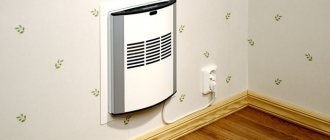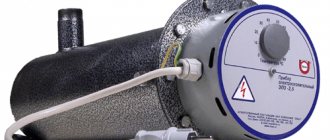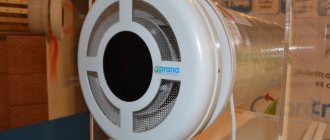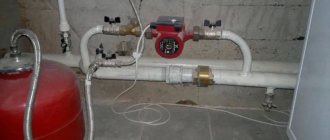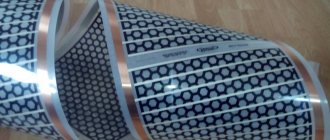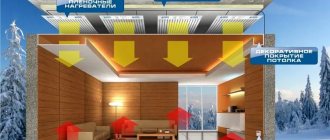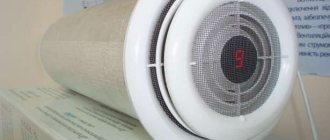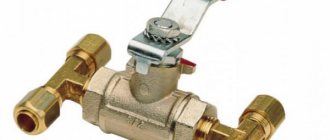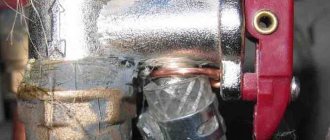In a modern metropolis, fresh air is a necessity for a full-fledged existence. In order to ventilate the apartment, it is not enough to simply open the windows, because dust immediately begins to settle on the furniture. And in winter, to maintain a comfortable temperature you have to use a convector. The recuperator can solve all these problems. This device is part of the ventilation system; in winter it prevents heat loss, and in summer it prevents heat from entering the house. Moreover, the supply and exhaust system reduces the level of humidity, prevents the appearance of fungus on the walls, and prevents all kinds of dust and pollen from entering the house.
But to truly enjoy comfort, it is important to choose the equipment wisely and understand how it functions.
Recuperator: what is it?
Air exchanger device
Supply and exhaust ventilation with a recuperator consists of several parts:
- device for air intake from the street;
- a device for removing air from the room to the street;
- ventilation with recuperator;
- connecting channels;
- adjustable diffusers that control the direction and amount of air moved.
The main difference between this system and conventional ventilation is the heat recuperator. Fresh air from the street passes through a heat exchanger, where it meets warm indoor air. The streams do not mix, but the cold stream warms up and enters the house already warm. This heating method makes it possible to achieve the optimal temperature in the room without increasing heating costs.
The device will eliminate fogging of windows and high humidity in the room
Additional selection criteria
When choosing a recuperator, it is important to pay attention to the noise level it creates during operation. This indicator depends on the material from which the device case is made, on the thickness of the case, on the power of the fans and on other parameters.
According to the type of installation, recuperators can be suspended (mounted on the ceiling) or floor-mounted (installed on a flat horizontal surface or hung on a wall). Exits for ventilation ducts can be either on both sides (“through” layout) or on one side (“vertical” layout). Which recuperator you need depends on the specific parameters of your ventilation system and on where exactly the supply and exhaust equipment will be installed.
Air recuperator for home – what is it for?
Ventilation devices that promote air movement and have a heat exchanger help maintain a comfortable temperature in the house and protect the health of its inhabitants. Thanks to the air exchanger, there will be no accumulation of carbon dioxide in the house, and there will be no dampness or extraneous unpleasant odors.
Installing a recuperation system makes life easier for allergy sufferers
Forced ventilation frees the indoor air from irritating dust, pollen and other allergens. Another reason why you should use a recuperator for a private home is beneficial savings on heating.
Natural ventilation
Natural impulse ventilation is a system that includes wall and window supply valves (providing fresh air into the room), as well as a system of exhaust air ducts (removing waste air from toilets, bathrooms and kitchens). The possibility of air exchange in the presence of natural ventilation is ensured by the difference in temperatures inside and outside the room.
The advantages of such a system are its simplicity and low cost; the disadvantages include low efficiency and insufficient quality of air exchange. Also, the disadvantages include a large load on the heating system and seasonal instability. For example, in the summer, when the temperature of indoor and outdoor air equalizes, air exchange in the room practically stops. In winter, on the contrary, the system works more efficiently, but this requires additional costs for heating the air coming from the street.
Air recuperator functions
The recuperator is a heat exchanger that is used in a supply and exhaust unit, and allows you to heat the supply air without using electricity or hot water. The heat exchanger works in two directions, keeping the room warm. Heated air is removed from the room, and air from the street enters the room, heated to a comfortable temperature. Modern models are equipped with an automatic control unit for ease of use. Supply and exhaust ventilation with a recuperator creates a favorable microclimate and saves money.
System power calculation
Ventilator for large rooms with high power
The dimensions and power of the recuperator affect the performance of the device. The larger the area of the ventilated room, the more powerful the recuperator will be required. Therefore, before purchasing a device, you should calculate the power of the recuperator.
For this, the formula is used: Q = 0.335 x L x (T1 – T2), where:
- Q (W) – device power;
- L (m3/h) – the volume of air required for normal human life. According to the norm, one person requires 60 m3/h;
- Т1 (оС) – air temperature after recovery;
- Т2 (оС) – air temperature before recovery.
For example, let’s calculate the power of a recuperator for an apartment inhabited by 3 people. The temperature of the air transported to the premises must be at least 20 ° C, and air supplied from the street with a temperature of -10 ° C. Q = 0.335 x 180 x 32 = 1929.6 W.
When carrying out the calculation, you should take the minimum possible temperature (on average over 5 years), which was observed in the region where the recuperator is planned to be installed. If the device is not planned to be used as the main source of heating the room, then the temperature indicators are selected individually.
Main types of recuperators for a private home
Plate air exchanger
It is considered the most functional and relatively inexpensive. Has varieties:
- aluminum, favorably differing in price;
- plastic, having a higher efficiency compared to metal;
- cellulose - the most effective, but unstable to high humidity.
Plate devices are very unpretentious in maintenance, rarely fail and do not require the use of electricity.
The downside of this device is freezing in winter.
Rotary devices
Inside this device there are plates that rotate when air moves.
The devices are characterized by high efficiency and resistance to moisture.
The rotor rotation speed can be changed, which increases the performance of the device. The disadvantage of a rotary recuperator is the need to use consumables - filters. The rotor requires periodic maintenance and runs on electricity.
The best models of household recuperators
The following table shows the best models of recuperators from the most popular manufacturers of such equipment presented above. The cost of the devices is as of 2019.
| Model | Specifications | price, rub. |
| "Electrolux EPVS-200" |
| 25 000 |
| Model | Specifications | price, rub. |
| "Mitsubishi Electric VL-100EU5-E" |
| 33 000 |
| Model | Specifications | price, rub. |
| "Royal Clima RCS 350" |
| 34 500 |
| Model | Specifications | price, rub. |
| "Blauberg VENTO Expert A50-1 Pro" |
| 20 000 |
| Model | Specifications | price, rub. |
| "Vent Machine PVU-350 EC Zentec" |
| 150 000 |
Advantages and disadvantages of different types of recuperators
The advantage of recuperators is obvious - they allow you to significantly save on heating the supply air in winter and cooling the supply air in the summer. Among the disadvantages of recuperators are the following:
- They create additional aerodynamic resistance in the network. Indeed, like any other element in the ventilation network, recuperators have some resistance, which should be taken into account when choosing a fan. However, this resistance is not high (usually no more than 100 Pa), and does not lead to a significant increase in fan power.
- Recuperators increase both the cost of the ventilation unit and the cost of its maintenance. Like any other solution aimed at increasing the energy efficiency of the system, recuperators cost some money and require regular maintenance. However, experience has repeatedly proven that the costs of heat recovery are much lower than the benefits obtained.
- Rotary, chamber and, to a much lesser extent, plate heat exchangers have one drawback, which can be critical at some facilities - leakage of air flows is possible in them. In this case, the danger is the flow of exhaust air into the supply air. Such leaks are undesirable in clean room ventilation systems and are not acceptable, for example, in infectious diseases departments of hospitals and operating rooms. The reason is the danger of viruses that have entered the hood from any room flowing into the supply air flow with subsequent spread throughout all rooms of the facility. As a result, recuperators with intermediate coolant or freon recuperators are used at such facilities.
- Recuperators increase the dimensions of the ventilation unit. This primarily applies to plate recuperators, since they are air-to-air heat exchangers and are quite large in size. In addition, this applies to recuperators with intermediate coolant due to the presence of two separate heat exchangers, two pipeline lines and piping units near each of the heat exchangers.
Design and principle of operation of the equipment
During removal, waste streams pass through a heat exchanger, giving off heat. This is the basic principle of operation. The recuperator consists of a housing to which pipes are connected, fans, filters and heat exchange cassettes are mounted.
- The air is collected through ducts;
- With the help of a fan it is supplied to the system;
- Passed through a recuperator;
- Released into the atmosphere;
- Fresh streams are taken from the street and passed through the recuperator again;
- Partial heat is taken away and transferred to the incoming inflow.
Rotary
Works using a rotating element. The drum is made of aluminum foil with high heat conductivity. When removed, heat is transferred to incoming air masses.
The device is not susceptible to frost. There is less dryness in the rooms. The rotary heat recuperator for ventilation air consumes electricity economically. The required number of rotor revolutions is set. Using the rotation speed controller, the thermal output power is changed. Operating efficiency: 87%
Lamellar
The inlet and outlet flows are enclosed by aluminum plates through which heating occurs. Condensation appears on the plates. In frosty weather outside, ice appears in the device. You can melt it with an electric heater.
During heating, no heat exchange occurs, the operating efficiency is zero. Overall performance decreases. After heating the cold air in operating mode, the efficiency is on average 90%.
Recirculating water
Liquid is used to transfer heat. It can be compared to the operation of a boiler, which is replaced by a heat exchanger and built into the hood. The role of the radiator is played by another element, which is intended for the flow entering from the street.
In the first, the water heats up, in the second, it gives off its heat. The equipment consumes electricity and is not designed to exchange air humidity. Forced circulation of the coolant is reduced only to the removal and transfer of heat into the room. Energy efficiency is 40% - 70%.
Chamber
Cold and heat meet in a common chamber, which is separated by a damper. The design includes movable elements. After a certain period of time, the damper rotates, changing direction. Heat is transferred through the walls of the chamber. The exhaust air heats one half of the chamber, then the control element directs the flow from the street.
After heating, the process is repeated again. Due to the mobility of the built-in parts, there is a possibility of mutual mixing of incoming and outgoing air. Contamination of the clean flow and transmission of all kinds of odors from the outside cannot be ruled out. The efficiency of the device is 70% -80%.
Freon
Freon tubes are used as a recuperator. Freon evaporates in warm air. At low degrees it cools with the formation of condensation. The flows are located in heat pipes-thermosiphons. These are hermetically sealed copper tubes filled with freon.
One end of the pipe in the exhaust stream heats up, the contents of the tubes boil and transfer heat to the other end. Freon condenses and gives off heat. As a result, the temperature rises. Efficiency: 50-70%.
A prerequisite for the operation of a freon recuperator: the air ducts must be installed in a vertical position one above the other.
Buying guide - which recuperator should I buy?
In the autumn-winter period, insufficient ventilation, causing heat loss, can affect the cost of heating the entire house. Therefore, to ensure not only comfort, but also lower costs, it is worth buying a good recuperator . This will improve air exchange while reducing thermal energy loss. We have prepared a guide in which you can read which recuperator to choose so that it brings the best results.
Recuperator efficiency
The most important parameter that should be taken into account when choosing a recuperator is its efficiency, that is, possible heat recovery. It is stated as a percentage and indicates how much thermal energy is stored during air exchange. The higher the parameter, the better. Typically, the efficiency of recuperators reaches from 80% to 98%. High heat recovery reduces building heating costs.
Recuperator efficiency
You might like it How to choose a good refrigerator based on quality, price and reliability: 10 tips for dummies
The best recuperator should not only have adequate efficiency, but also good efficiency. It measures how much air moves through a system over a period of time, most often an hour. This parameter affects the efficient operation of the recuperator. Its effectiveness should be correctly selected taking into account the size of the room or the entire house. Thanks to this, it will be possible to effectively retain heat and ensure proper air exchange. A parameter that is also worth paying attention to when purchasing is pressure. It shows what resistance in the installation a given recuperator can overcome, that is, its actual efficiency. The compression ratio is usually indicated by the symbol Pa, and the optimal value is between 150 and 200 Pa. However, manufacturers do not always provide this parameter.
What needs to be taken into account in the operation of different equipment models
Each air recovery system for a private home has its own strengths and areas of application.
The ventilation system in a private house with recuperation involves not only maintaining temperature and humidity levels, but also eliminating unfavorable odors. There is a varied selection of models on the market, differing in their functional characteristics and installation methods.
For example, a hood installed in the ventilation allows you to remove soot, odor and grease. At the same time, clean air enters the room, and greasy dust does not settle on the furniture. Such conditions have a beneficial effect on well-being and make cleaning the room easier.
Plate heat exchanger
The design of the heat exchanger is such that, due to separation by metal plates, the air flows do not mix. This simple engineering solution provides more efficient heat transfer. To create such equipment does not require large investments. Due to the absence of moving parts, such a device will last a relatively long time. Currently, the efficiency of such devices reaches 60-65%.
The elements are made of aluminum alloys. They are not subject to corrosive changes and have high heat transfer rates.
Rotor system
In such equipment, a small part of the air flows is mixed, since the air flow insulator is a brush with fine bristles. The rotor system occupies a larger area than the plate system, but also has high efficiency (up to 86% in the best models). The rotating rotor and the belt that turns it reduce the overall reliability of the device and increase energy costs for recovery.
Liquid recuperator in an office building
Scheme of liquid recovery in an office building
These are expensive models, but their efficiency is no higher than that of similar equipment. The main positive difference is the ability to place individual blocks at a great distance from each other. Therefore, liquid recuperators are mainly used in large commercial buildings. In private residential premises, a plate or rotary air recuperator for the home is usually used.
Breezer
An air recovery system for a private home and a breather differ in their purposes. The direct purpose of a breather is to heat the air. There is no heat exchange process in it, so it will take a lot of electricity to increase the air temperature.
Compact recuperator model
This model is local ventilation with a recuperator in a private house. Its use is worth thinking about. Compact models can be installed in the walls of different rooms. They operate separately, so they do not require connection to a centralized installation that configures and controls the operation of all devices.
In such models, due to the built-in fans, two air flows move synchronously. Work productivity can be changed using the remote control. At night, the device can be switched to quiet operation mode.
To prevent freezing, special channels are provided, next to which some of the warm air passes. But the effectiveness of this protection remains only up to -15ºС. Activating the exhaust mode helps remove frost and ice from the surface of the heat exchanger. This mode will also cope with purifying the air in the room from choking smoke and other pollutants.
A built-in filter protects against the penetration of debris from the street. The size of the filter cells is selected in such a way that it does not create any special obstacles to air flow, but protects against the penetration of insects and plant fluff. For maintenance, a removable cover is attached to the inside of the recuperator.
How to find out the efficiency of a recuperation system
Formula for calculating the efficiency of a recuperator
When making a recuperator yourself, it is not always possible to assemble a device with maximum efficiency. Moreover, the efficiency of the recuperator depends on the temperature and humidity of the air outside the room.
To calculate the efficiency of the recuperator, the formula is used: H = (tр - tу) / (tд - tу), where:
- tр – air temperature after recuperation;
- tу – air temperature before recovery;
- td – temperature of exhaust air leaving the room.
The total value should be multiplied by 100%. For example, let's calculate the efficiency of a device for specific conditions. The air temperature outside is 5 oC, after recuperation - 17 oC, indoors - 24 oC. Efficiency = (17 – 5) / (24 – 5) = 0.63 * 100% = 63%.
How to improve an air recuperator for your home
To increase efficiency, you can install several heat exchangers in series. If you install two heat exchangers with fans in one room, you can separate the channels and improve performance
Precise filter selection will ensure good cleaning at a reasonable fan load
Tips for choosing
Regarding the operating diagram of the equipment:
- a recuperator with ventilator functionality can be installed only on the supply of fresh street air, and the exhaust air will be removed naturally through an exhaust hood;
- a counterflow device, which simultaneously works for inflow and removal, is capable of providing complete ventilation to a single room;
- devices with additional connection of air ducts are aimed at servicing several rooms or the entire apartment at once through one installation;
- It is recommended to install units operating in reverse mode in pairs. This eliminates disruption of the air balance in the apartment or house;
The considered operating schemes are basic, however, the specific scheme and choice of the number of devices is best discussed with specialists.
Regarding the number of storeys of the building:
- Due to possible strong gusts of wind, it is not recommended to install heat exchangers in apartments above the fifth floor, especially if the installation site is not protected. Strong wind can negatively affect heat transfer characteristics and the functioning of fans. Also, due to the height of the floor, weaker natural exhaust should be taken into account.
- For the upper floors, a compact air handling unit with heating and cleaning functions is suitable. Supply and exhaust ventilation can also be used - for a separate room or apartment.
It would also be a good idea to take into account the layout of the house/apartment - are there doors between rooms and gaps under the doors for flow, passage rooms or not, is there free access of air from living rooms to the kitchen and bathroom.
Which company is better?
The best manufacturers of climate control equipment are:
- Breezart;
- Turkov;
- Blauberg;
- Royal Clima;
- GlobalVent;
- Soler & Palau;
- VAILLANT.
Popular models are produced by Maico (Germany), PRANA (Ukraine), VAILLANT (Germany), TION (Russia), MITSUBISHI ELECTRIC (Japan), VENTS VENTS (Ukraine).
Where to buy and how much does it cost?
The price of the devices varies depending on the brand and the performance of the entire ventilation system. In order to determine the price, it is necessary to develop a competent project that will meet specific requests and conditions. Not only the efficient operation of the entire system, but also the amount of further maintenance costs depends on the quality of the project. According to buyers, you can select the equipment yourself, and this is true - air ducts, grilles and other elements are available for purchase, but it is best to have a professional deal with these issues. The designer will have to pay additionally, and at first glance, such expenses seem impressive, but in the future this will avoid many possible problems and unexpected costs during repairs.
When choosing a recuperator, you should first of all evaluate the price/quality ratio. You shouldn’t immediately grab new products or overpay a significant amount just for a well-promoted brand. After all, the equipment is not cheap and will pay for itself for several years.
You can purchase the device by visiting a specialized store or ordering online from an online store. But regardless of the chosen place of purchase, you should definitely study the product description and reviews, as well as check for product certificates and find out how long the warranty is valid. As a rule, it is given not for the entire device itself, but for its individual components. Therefore, the higher the quality of the components, the more expensive the equipment will be.
Advantages and disadvantages
Advantages of recuperators:
- Regular cleaning of harmful substances - dust, small contaminants, exhaust gases, allergens and other possible emissions typical of megacities and cities with a large number of industrial enterprises;
- Organization of high-quality ventilation of the room without dangerous drafts;
- Significant savings on heating, which is obvious primarily to people living in private homes;
- For apartment buildings with a central heating system, thermal savings are not so relevant, but there is an acute problem with ventilation and access to fresh air;
- Where the unit is installed, cleaning must be carried out 2-3 times less often.
Flaws:
- Plate models are prone to freezing in winter, which requires periodic shutdown of equipment or more expensive equipment;
- Moving parts of the structure (especially in rotary models) require periodic maintenance;
- A tangible cost that can only be recouped in a few years.
Main technical characteristics
| Number | Characteristics | Recommendations |
| 1 | Control system | In the simplest version, the recuperator does not have a control system, but is equipped with a damper that allows you to regulate the throughput of the heat exchanger. In other cases, the heat exchanger is the only element that forces the flow; accordingly, the operating speed of its fans determines the intensity of air exchange. For such units, manual switching of modes is provided. There are also models whose operation is regulated by a remote control. The most modern models can be connected to a general house automation system and automatically adjust performance based on data on the number of people or information received from room gas analyzers. |
| 2 | Thermal accumulators | The weakness of many household recuperators is the icing of the heat exchanger during the cold season. To prevent this from happening, the best models are equipped with heat accumulators, as well as heavy-duty fans. |
| 3 | Filters | The devices are equipped with filters to clean the incoming air from contaminants. As a rule, different filters are installed on the incoming and outgoing flows - fine and coarse filters. |
| 4 | Noise level | Recuperators are quite noisy equipment, and therefore they are most often installed in utility rooms. When choosing a device that is planned to be installed in living rooms, it is important to pay attention to the noise level. |
| 5 | Lifetime | The operating life of the equipment is approximately 10 years, the warranty period varies within 3 years - depending on the manufacturer. |
| 6 | Additional modes | Additional functions that may be present in recuperators include night mode, operating mode using a CO2 sensor, and the ability to connect to a “smart home” system. |
| 7 | Installation | Provides for installation of the device at a certain angle on an external wall of a certain thickness (from 300 to 600 mm). A channel is punched into the wall and thermal insulation around the body is required, as well as sealing gaps in the wall. You must first de-energize the room so that you can lay the electrical wiring to the control panel. Models with wireless control only need an outlet to connect power to the heat exchanger. In the absence of special skills, it is best to involve specialists in the installation. |
Tools and materials
An approximate set of materials and tools:
- metal 0.5-1 mm, textolite or cellular polycarbonate 1-5 mm in quantities of 5, 10 or 15 m2 depending on the type of recuperator;
- slats 2-3 mm made of wood, technical cork or plexiglass, 1-1.5 cm wide;
- stainless steel, chipboard, plywood for the body according to the drawings;
- mineral wool, polystyrene foam for thermal insulation;
- 4 plastic flanges for air ducts based on sewer pipes;
- jigsaws for wood and metal, preferably electric;
- silicone sealant;
- aluminum tube 2-5 mm, length according to the project;
- universal glue;
- self-tapping screws;
- steel corner 20x20 mm, length according to the project;
- screwdriver, hacksaw;
- paper filters, automobile filters - as many as needed;
- construction knife;
- hammer;
- drill, set of drills;
- computer or duct fans depending on the project.
Filters are replaced or cleaned every 1-4 months.
HEPA filters are recommended. They are inexpensive, yet perform very deep air purification; they are available in different sizes.
We prepare materials according to the selected type of recuperator.
What are they?
Units are divided into the following types:
- By type of design - shell and tube, spiral, rotary, plate, plate finned.
- By purpose - air, gas, liquid. By air we mean a ventilation unit whose task is ventilation with heat recovery. Gas-type appliances use smoke as a coolant. Liquid recuperators - spiral and battery - are often installed in swimming pools.
- According to the coolant temperature – high-temperature, medium-temperature, low-temperature. High-temperature heat exchangers are those whose coolants reach 6000 C and above. Medium temperature devices are devices with coolant characteristics in the region of 300-6000C. The coolant temperature of the low-temperature unit is below 3000C.
- According to the method of media movement - direct-flow, counter-flow, cross-flow. They vary depending on the air flow direction pattern. In cross-flow units, the flows follow perpendicular to each other, in counter-flow units, the inflow and exhaust are opposite to each other, and in direct-flow units, the flows are unidirectional and parallel.
Shell and tube heat exchangers
They have the simplest device. Disadvantages - weight, dimensions, difficulty in maintenance.
Spiral
In spiral models, heat exchangers look like two spiral-shaped channels through which media move. Made from roll material, they are wound around a dividing partition located in the center.
Rotary recuperators
Installed in supply and exhaust ventilation systems. Their method of operation is based on the passage of supply and exhaust flows through a special rotary heat exchanger of a rotating type.
Plate heat exchanger
It is a recuperator where heat is transferred from a hot medium to a cold one by passing through steel, graphite, titanium and copper plates.
Finned plate recuperator
Its design is based on thin-walled panels with a ribbed surface, produced using high-frequency welding and connected to each other in turn with a rotation of 900. This design, as well as the variety of materials used, makes it possible to achieve a high temperature of the heating medium, minimal resistance, long service life, high indicators of the heat transferring area in relation to the total mass of the heat exchanger. In addition, such devices are inexpensive and are most often used to process heat from waste gaseous media.
The popularity of finned models is based on the following advantages (in comparison with analogs of the rotary and traditionally plastic type):
- high operating temperatures (up to 12500C);
- small weight and dimensions;
- more budget friendly;
- quick payback;
- low resistance along gas-air paths;
- resistance to slagging;
- ease of cleaning channels from contaminants;
- long service life;
- simplified installation and transportation;
- high thermoplasticity rates.
Industrial and household heat exchangers - what are the differences?
Industrial units are used in industries where thermal technological processes are present. Most often, industrial heat exchangers mean traditional plate heat exchangers.
Household installations include devices characterized by small dimensions and low performance. These can be supply and exhaust models, the main task of which is ventilation with heat recovery. Such systems can be implemented in different ways - both in the form of a rotary and in the form of a plate heat exchanger. Moreover, each of them has its own advantages and disadvantages.
Next, we will consider the main selection criteria to understand which recuperator is better to buy.
Making an air recuperator for your home with your own hands
A simple plate recuperator can be made by yourself.
To work you need to prepare:
- four square meters of sheet material: iron, copper, aluminum or textolite;
- plastic flanges;
- box made of tin or plywood, MDF;
- sealant and mineral wool;
- corners and hardware;
- cork sheets with adhesive backing.
Heat exchanger device
Sequencing:
- Square plates measuring 200 by 300 millimeters need to be made from sheet material. In total, seven dozen blanks will be required. The main thing in this stage is accuracy and strict adherence to the parameters.
- A cork coating is glued to the workpieces on one side. One workpiece is left without coating.
- The blanks are assembled into a cassette, rotating each subsequent one by ninety degrees. The plates are fastened together with glue. The uncoated plate is the last one.
- The cassette needs to be fastened with a frame; a corner is used for this.
- All joints are carefully treated with silicone.
- Flanges are attached to the sides of the cassette, a drainage hole is drilled at the bottom and a tube is inserted to remove moisture.
- So that the device can be periodically removed, guides for the corners are made on the walls of the case.
- The resulting device is inserted into a housing, the walls of which are insulated with mineral wool material.
- All that remains is to insert the air exchanger into the ventilation system.
Advice! To monitor the formation of ice on the path of warm air, it is better to install a pressure sensor. It will give a signal if the movement of the air mass is difficult.
Installation and connection of the recovery system
To connect the recuperator, a crimp clamp, sealant and aluminum adhesive tape are used
The installation process of the recuperator depends on the type of device. In most cases, the device is mounted in a similar way to other components in the system. For example, to install a plate recuperator, the manufacturing technology of which was described above, you will need:
- With the help of a partner, the structure rises to the ceiling. Markings are made for holes for attaching steel studs. Next, holes are drilled, plastic plugs are hammered in and steel pins of the required length are screwed in.
- The recuperator rises again to the ceiling and is fixed at the desired height. To do this, a steel plate is mounted between the studs, which will hold the recuperator in weight.
- To connect the device to the duct system, you will need to treat part of the connecting flange and the crimp clamp with a solvent. After this, the inside of the clamp is coated with sealant and fixed to the flange. The air duct to the recuperator is installed in the same way. The joints are taped with aluminum adhesive tape.
Video: installation of a ventilator with a recovery system
Features of installation and operation
Currently, recuperators with floor and wall mounting are being sold. There is also a point wall type that can be installed in any room that is adjacent to the street and processes flue gases. Such devices do not require additional communications.
Ceiling installation of a window duct device allows the master to hide all the elements of technical equipment , so this device looks quite neat. Compact recuperators are characterized by some noise, as they operate close to the ventilation grille. It is better to install floor- and wall-mounted equipment in a technical room. This device has good performance, but is large in size.
The diagram of the process of installing and connecting the recuperator comes down to its mechanical fastening to the permanent surface, as well as docking with common exhaust and supply ducts.
At the end of this procedure, it is necessary to seal the joints and cover the recuperator with a specially designed casing. The latter is necessary for noise absorption, as well as thermal protection. More difficulties involve designing a ventilation system, provided that it includes the installation of a recuperator.
A forced ventilation system with recovery is an opportunity to save heat and electrical energy. The purchase of a special air exchanger is considered especially relevant for apartments and private houses. This investment pays for itself quite quickly and also helps maintain a healthy indoor microclimate.
Recuperator prices and operating costs
Before purchasing a recuperator, it is worth checking its operating costs, which mainly include energy consumption, system inspection and maintenance, and filter replacement. However, the biggest investment is usually the purchase of the device itself. Recuperators can be found at good prices in many online stores and brick-and-mortar stores. It is recommended to compare several models and their prices before making a final decision.
The cheapest recuperators can be found for less than 8,000 rubles. Compact versions, which are well suited for small apartments, are available at prices starting from 12,000 rubles. You have to pay more for recuperators for large premises with high efficiency. Their prices start at 120,000 rubles. However, it is worth buying good equipment from a trusted manufacturer recommended by users.
Self-production of a recuperator
Today on sale you can find various models of factory-made air recovery systems for a private home, which are distinguished by their build quality, have high efficiency rates, and their installation is not difficult. However, the high price of such equipment negatively affects its popularity on the Russian market.
Therefore, many domestic homeowners make their own heaters, which can be made from scrap materials using simple tools. You just need to think about the type of design, and also calculate the power of the installation, which should match the performance indicators of the entire ventilation system in the house.
The easiest way to make your own is a plate-type recuperator for a private house, which is characterized by its simple design and efficiency. You can find numerous designs for such equipment, which greatly simplifies the work; at the same time, it is possible to accurately calculate the power of a particular installation.
The advantages of homemade plate recuperators include the following:
- Long service life.
- Simplicity of the materials and functional elements used.
- Reliability of the design.
- Full autonomy and no connection to the power supply.
- High efficiency.
The only disadvantage of such heaters for the ventilation system is the likelihood of ice formation during severe frosts, which negatively affects the efficiency of the installation, up to the complete cessation of heating the air coming from the street. To solve such icing problems, it is necessary to additionally insulate the recuperator or install it in a warm heated room.
Homemade cassette-type recuperators are very popular, they are effective and at the same time completely solve problems with condensation and icing at low temperatures. Such heaters and their cassettes can be made from cellulose, and the body of the device is made of tin or any other metal that is well protected from corrosion.
Required components and materials
Before directly starting to manufacture the recuperator, it is necessary to prepare the tools and materials used. For this work you will need the following:
- Computer fan.
- Four flanges.
- Corner.
- Hardware.
- Sealant.
- Glue.
- Plywood or metal for the body of the device.
- Mineral wool for insulation.
- Wooden slats for the base.
- Aluminum sheets for making cassettes.
You can use ready-made cellulose cassettes, which are produced for car filters and air conditioners. Their use makes it possible to significantly simplify the manufacture of a recuperator, increasing its power and subsequently simplifying the maintenance of home-made equipment.
Finding easy-to-implement schemes for making homemade recuperators on the Internet is not difficult. Also, the simplest drawings can be completed independently, taking into account the power of the equipment and the required productivity. You should not make such a device without a manufacturing diagram, since in the future it will be difficult to correctly assemble the entire system, which negatively affects the reliability of the equipment and its efficiency.
Heater assembly
Assembling the recuperator is not particularly difficult. It is necessary to cut at least 70 sheets of metal with side sizes from 200 to 300 mm. Wooden slats are prepared, the dimensions of which must completely correspond to the sides of the cut metal sheets. The wood should be treated with drying oil, which will prevent rotting and loss of strength of the internal elements of the heat exchanger. The prepared slats are glued with glue on both sides of the metal squares. Having collected all the blanks, you can proceed to the next stage of work.
The assembled squares should be alternated with a 90-degree rotation, which will ensure a perpendicular arrangement of the cassettes inside the recuperator, thereby guaranteeing maximum heating efficiency of the air flows without mixing them. The upper square, to which the slats are not attached, is glued to the lower one using special metal glue. Additionally, to increase the strength of the structure, it is tightened with corners and fixed with self-tapping screws or similar fasteners. The cracks should be treated with sealant, after which flange mounts are formed.
The heat exchanger of the supply heat exchanger is ready. All that remains is to make the body of the device from metal or lumber and mount a honeycomb cassette inside the frame. The heat exchanger must be installed in such a way that it rests against the ribs, visually forming a rhombus through which cold air from the street and the heated flow from the house will subsequently pass.
If the body of a homemade recuperator is made of wood , the lumber should be treated with special impregnations, which will prevent them from rotting and rapid failure of the equipment. During operation, condensation will form on the heat exchanger, which drains from the metal cassettes, accumulating at the bottom of the housing. Small holes should be provided to remove moisture, which are located flush with the bottom of the device body.
At the last stage of the work, four flanges are attached to the wooden or metal body, which are made of polypropylene pipes or similar materials. They are fixed using appropriate clamps and fittings, additionally coated with sealant to ensure the maximum possible tightness of the manufactured device body.
To increase the efficiency of a homemade ventilation recuperator, it should be additionally lined with mineral wool, which prevents heat loss and the formation of condensation. The latter often appears if such equipment is installed outdoors or in an unheated room.
At the entrance of the installation, you can install air filters that provide primary air purification from existing contaminants, poplar fluff and various allergens.
The use of a recuperator in the ventilation system of a private house allows you to expand the functionality of such equipment, preventing the rapid cooling of rooms in the winter, which saves the homeowner's expenses on utility bills. Owners can purchase ready-made heaters that are compact in size, easy to install and efficient. You can also make a recuperator yourself, which will reduce the cost of installing utilities in a private home.
Reviews
Modern manufacturers offer a wide selection of devices of various capacities for air recovery in residential premises. If you are planning to purchase such equipment, we recommend that you read customer reviews.
Great stuff! It copes with its task completely. The air in our bedroom is always fresh, our sleep has improved significantly. We fall asleep faster and get up easier. I was a little afraid to install it in the bedroom, because you can still hear the sound of any device, but in fact it turned out that it is very, very quiet and does not interfere at all.
Marta Kononova
https://vk.com/topic-76874762_31432944
Excellent ventilation, windows are closed, no drafts. No unpleasant odors from the street. Clear controls and low price. The downside is a little noise. First I studied the range of ventilators. And compared to models costing over 100 thousand, this one seemed like a godsend. It does an excellent job of ventilating a room of 20 square meters, the filters are inexpensive and easy to maintain. Of course, we had to tinker with the installation, since our walls are thick, they were mounted on a glassed-in balcony. When ventilation is needed, open the door to the balcony and turn on the device. We are very pleased with the purchase.
Dmitry Ivanovich
https://www.vseinstrumenti.ru/klimat/ochistiteli-vozduha/tion/o2-standard/#tab-Responses
I had a problem with ventilating my apartment in the winter: if you close the window, it’s stuffy, if you open the window, it’s cold. I searched the Internet for a long time for a solution and found the MARLEY MENV-180 PRO. First I installed it in the children’s room. I liked it, put it in the bedroom and in the living room. Very pleased. Now I always have fresh air and warmth. I had a renovation done two years ago, and I was worried that there would be a lot of dirt during installation. But in St. Petersburg they offered a clean installation. I agreed, and indeed there was some dust, which I removed after installation in 30 minutes.
Sergey Tarasov
https://otzovik.com/review_4375124.html
About the principle of recovery
The term recuperation comes from the Latin word meaning exchange, transfer of something. In the context of ventilation, this concept means the transfer of heat from exhaust air to supply air without mixing the two flows. Initially, interest in recovery devices was dictated mainly by innovation trends and environmental safety prospects. Later it became clear that this is a truly effective way to optimize the energy efficiency of a building.
Operating principle of the air recuperator
The principle of return heat exchange has a quantitative expression. The efficiency of heat transfer increases as the temperature difference increases. Also, due to the absence of mixing of flows, it is obvious that full operation of the device is possible only with a sufficiently high ratio of the thermal contact area to the mass of air passing through the recuperator.
In essence and principle of operation, each recuperator is an economizer that collects low-potential energy waste and directs it to perform useful work. Heat recovery is not characterized by high efficiency, but in well-insulated buildings, heat loss through ventilation is the main loss, so reducing it is the most important task to ensure the lowest possible heat balance.
Defining Performance
For a recuperator as part of ventilation, the most important three parameters are: reduced aerodynamic resistance, permissible flow and efficiency, expressed in relation to the recovered heat to the total amount of energy contained in the air at the current temperature delta. This relationship is not constant: the colder the supply air, the more efficient the recuperator generally works, and the dependence of these changes is not linear. Therefore, it is so important to pay attention to diagrams of changes in basic characteristics depending on other conditions.
Q = S v 3600
Where:
- Q — ventilation duct capacity, m3/h;
- S—channel cross-sectional area, m2;
- v—flow velocity, m/s.
Kt = (T3 – T1) / (T2 – T1)
Where:
- Kt—recuperator efficiency coefficient by temperature;
- T1 — outside air temperature, °C;
- T2—room air temperature, °C;
- T3 — supply air temperature, °C.
The initial criterion - the permissible flow rate - is determined by the parameters of the ventilation system. Of course, the air exchange cannot be lower than the standards established by SNiP: 3 m3/h m2 or 30 m3/h for each person with a space provision rate of less than 20 m3/person. In this case, the total air exchange rate per hour should be at least 0.35. If the parameters of the ventilation system do not currently meet the standard, the recuperator is selected according to regulatory requirements, and the ventilation system is subsequently modified.
If the capacity of a recuperator with forced air movement exceeds the capacity of the ventilation system by more than 50%, excess noise is eliminated by installing a muffler. You also need to remember that the fan performance on the supply duct is higher than on the exhaust duct; the difference must be selected in accordance with the number of additional points of natural air removal.
Air heat and moisture recuperator
There are no specific requirements for the energy efficiency of the installation; in general, this parameter is important for determining the profitability of the purchase. You can estimate the conditional efficiency of the device using online calculators and data from the manufacturer; the difference in supply air temperatures is taken as the reference point. Additionally, you need to pay attention to the restrictions on air humidity and temperature difference; due to the discrepancy between these indicators, the recuperator may freeze in winter.
